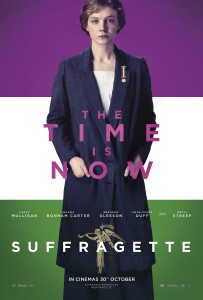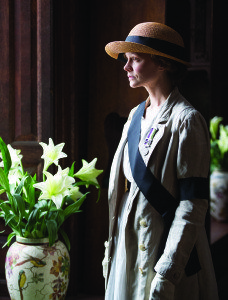Suffragette – A “White Feminist” hit?
From watching the trailer, it’s not difficult to see why Suffragette is a favourite for awards season; with the likes of Meryl Streep (Into the Woods, The Iron Lady) and Carey Mulligan (Far From the Madding Crowd, The Great Gatsby) leading the way in this retelling of the suffrage movement, coupled with a female director and screenwriter, it looks set to be a feminist hit. Or, at the very least, a celebration of the accomplishments of women on many levels. However, just how far it can be considered so is limited by its lack of inclusion of people of colour – a fact which, unfortunately, is only too prevalent in Hollywood today.
Why have I bothered to consider race when the film is about women, you might be wondering? Well, history hasn’t taken place in a vacuum, especially the history of women’s rights. You need only glance back at second-wave feminism and the crisis of the left to see how large a part race played and, indeed, to the time of the suffragettes and the imperial rhetoric which propelled their cause. Not to mention that, to be a feminist film, it should be intersectional. However, I’ll come back to that later.
In case you haven’t seen the trailer, here’s a quick overview: Suffragette follows the tumultuous years of agitation for the vote in Britain, in the 1910s – specifically that of the working-class section of the militant suffragettes. Focusing on Carey Mulligan’s character, Maud, a laundry-worker turned ‘footsoldier’ in the fight for votes for women, it attempts to take a personal approach to the history of the movement. Scenes range from the infamous Black Friday march, which was mostly attended by the middle-classes, to the races, where Emily Wilding Davison gave her life to the cause. And, amid the action, there are scenes bound to tug on your heartstrings too; the trailer teases at the strain of Maud’s relationship with her husband, as a result of her involvement with the suffragettes.
So, when this film is the first to depict and celebrate a part of the women’s movement, does it matter that not one person of colour was included in the trailer?
Yes it does.
The suffragette movement took place during the height of the British Empire. The Boer War and the ‘Scramble for Africa’ had been and gone and British pride in the empire was taking over much of the rhetoric as reasons for why women should gain the vote. Especially the concern they had over ‘saving’ their ‘Indian sisters’. It is no coincidence, therefore, that the only march which united almost all suffrage groups was the Women’s Coronation Procession of 1911. And no surprise that there appears to be no mention of it in the film.
However, it is true that the consideration of Britain’s imperial mission was mostly utilised by the middle class and, since Suffragette is focused on the working class, none of that will appear particularly relevant. Until you remember that Britain was not an island cut off from the rest of the world, but wholly invested in and profiting from, countries they had colonised; while many British people went to live abroad, various people from the colonies came here.
So, even without the fancy procession and its Empire Pageant, many people of colour would have featured in everyday life as servants, indentured workers and even visitors. Not to mention the Indian suffragettes and suffragists, one of whom was Princess Sophia Duleep Singh, whose godmother was the Queen. Don’t believe me? Just look at the British Library’s timeline on ‘Asians in Britain’.
Why weren’t there any people of colour featured in Suffragette’s bustling streets of London, then? What’s a few in the background here and there? Perhaps it’s because every historical film has its inaccuracies; the way history occurs rarely fits into a neat linear story as films might have us believe. So, the need for an appealing ‘story’ outweighs the need for accuracy. After all, is it really possible to follow the experiences of one working-class woman in the movement? Unless she’s Annie Kenney, that’s highly doubtful.
Perhaps it’s because every historical film has its inaccuracies; the way history occurs rarely fits into a neat linear story as films might have us believe.
However, the inclusion of people of colour would not change that story; it would only enrich it. So Suffragette joins a long list of films which unnecessarily whitewash or omit people of colour, historical or otherwise (see Exodus and Star-Trek: Into Darkness).
Regardless, all hope is not lost. When you see Suffragette in October, don’t forget that this film only tips the iceberg in the narration of women’s suffrage. There are many more stories yet to be told and, who knows, perhaps the next one will be a little more intersectional. Until then, let’s hope Suffragette proves that the history of women is profitable so it can pave the way for the rest.



Comments (5)
Despite the somewhat melodramatic tone, Carey and the other actresses kept me glued to the screen. It also brings up issues relevant to today’s social movements, such as, is violence ever acceptable in pursuit of social justice? The combination of real and fictitious characters worked for me, and the production values were good.
The movie isn’t just about one woman’s awakening to the cause, it’s about how she essentially immolates her life and her identity to become a member of its infantry, which isn’t a less worthy story, but it is a much more difficult one to tell. Suffragette wants to celebrate women like Maud but ends up making her into an abstract — so much suffering, and all she got was a lousy T-shirt.